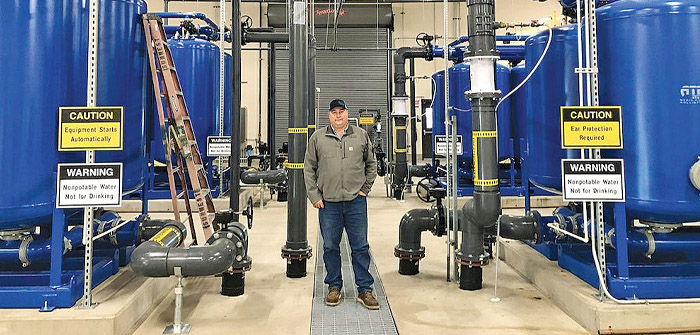(Prineville’s Aquifer Storage and Recovery (ASR) system won the League of Oregon Cities Award for Excellence in 2022 | Photo courtesy of Treatment Plant Operator)
Prineville, with a current population of 12,000 (a ten percent increase since 2020), and an annual growth rate of 3.2 percent, used to have four city planners. “Now it’s just me,” said Josh Smith.
“This means that unlike other towns where separate departments handle issues such as housing, attracting new businesses, job creation, and image improvement, I’m constantly bouncing between all of them. And as it’s impossible to focus on just one area without affecting the others, I’d describe what I do not as controlling these issues, but rather as managing them.”
Land Use Flexibility
During his 18 years on the job, Smith has found that “the key to making this work is trying to stay flexible — particularly in the area of land use. As City Manager Steve Forrester says, ‘We move at the speed of business, while still focusing on our mission of advancing Prineville’s economic vitality.’
How does this translate? According to Smith, “while we have to prioritize, and adhere to codes, we don’t need permits for everything that walks in the door, and try not to get wrapped around the axle like some cities. This means we can move faster. One example is the ease with which Facebook’s first data center was approved — it happened in about a month.”
Another example, he added, “is a 328-unit apartment complex that was recently approved in two months.” (Plans call for 11 three-story apartment buildings that will house 270 units, and a 58-unit cottage development consisting of single and duplex-style homes — providing a total of 188,600 square feet of total living space.) Once completed, it will be the largest multi-family development ever built in Prineville.
Advancing Quality of Life
The planning department’s mission also includes “advancing the quality of life.” In this regard, said Smith, “a city can’t just point to industrial and commercial development. Prineville is also developing its recreational options, which feature the new Barnes Butte recreation area, and the Crooked River Wetlands Complex with its network of walking, running and hiking trails. Prineville also has a large amount of public land within five miles of the city limits.”
In addition, he pointed out, the Crook County Parks and Recreation District manages 13 parks and three campgrounds, and is continually expanding its county-wide trail system in partnership with other local government agencies and the Central Oregon Trail Alliance.
Image Enhancement
Image enhancement is another planning department priority. “When I moved here in 1998,” said Smith, “I’d describe the prevalent attitude as ‘it’s good enough.’ People didn’t particularly care about having enough trash cans or benches in the downtown area, or enhancing its ‘curb appeal.’”
“What they didn’t realize,” he continued, “is that a nice main street will attract more people and more businesses. In that regard, I’d say that Prineville is ‘an emerging community’ — similar to Redmond 15 years ago.”
Rapid Growth in Diverse Economy
According to Smith, Prineville’s recent construction boom actually began back in 2010 with the first Facebook data center — the company plans to have 11 total buildings by 2027 — followed by Apple’s 338,000-square-foot facility on SE Baldwin Road. (The City approved an expansion in April, which will commence with site and infrastructure work.)
In the last three years, he said, “construction has exploded, with auxiliary manufacturers and contractors building like crazy. One result is the need to expand our industrial park, which has filled up so much that we’re looking at building a second one.”
Smith characterized Prineville’s economy as “diverse — encompassing a range of enterprises from Les Schwab to government agencies, and a secondary mill that produces wood products. The town can’t be pigeon-holed into one industry.”
And, he continued, “Prineville is set to continue its rapid growth. I predict that we’ll exceed our current three percent rate — whether everyone in the community wants it or not.”
Smith cautioned that “In order to accommodate that growth, the city needs more water, sewer and transportation infrastructure — an example being a large pump, and a new well and tank. One factor contributing to our increasing demand for water is the fact that Prineville is attracting more manufacturing businesses, which have greater water needs.”
Interest in Innovation
Fortunately, “one unique characteristic about Prineville is its interest in innovation and trying new approaches,” he said. “Our Aquifer Storage and Recovery (ASR) system, for example, is based on pumping water into the aquifer beneath the Prineville airport during the winter, when demand is low, and retrieving it during the summer, when demand is high — thereby reducing the need to build expensive storage facilities.”
The ASR system won the League of Oregon Cities Award for Excellence in 2022, and Redmond is interested in emulating our wastewater wetland system, said Smith. “In a similar cost-effective and sustainable vein, we’re exploring the use of wastewater — versus potable water — to cool local data centers.”
Smith added that “Prineville is also unique, especially as a small community, for owning a railroad (an 18-mile shortline connecting Prineville and Redmond) and a golf course. In addition, we manage our airport, which just received $450k in federal funds for runway and pavement improvements, and is constructing two rows of rental hangars to produce additional revenue for the city.”
Despite his responsibilities in such a range of critical issues impacting Prineville’s future, Smith remains modest and approachable. “One of the aspects I like best about my job is helping people, and offering information that they need. My attitude is ‘come in any time and ask questions.’





